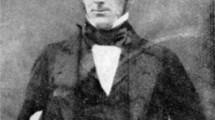Abstract
A new mechanism involving metal-bound surface electrophilic methylidynes is proposed for chain growth in the Fischer–Tropsch reaction to give 1-alkenes.


Similar content being viewed by others
References
Presented at the 13th international symposium on the relations between homogeneous and heterogeneous catalysis, Berkeley, CA, USA, July 17, 2007
Chiusoli GP, Maitlis PM (eds) (2006) Metal catalysis in industrial organic processes. RSC Publications, Cambridge
Turner ML, Marsih N, Mann BE, Quyoum R, Long HC, Maitlis PM (2002) J Am Chem Soc 124:10456 and references therein;
Turner ML, Long HC, Shenton A, Byers PK, Maitlis PM (1995) Chem Eur J 1:549
Ma F, Sunley GJ, Saez IM, Maitlis PM (1990) J Chem Soc Chem Commun 1279
Brady RC, Pettit R (1980) J Am Chem Soc 102:6181
Brady RC, Pettit R (1981) J Am Chem Soc 103:1287
Biloen P, Sachtler WMH (1981) Adv Catal 30:165
Zheng C, Apeloig Y, Hoffman R (1988) J Am Chem Soc 110:749
Mims CA, McCandlish LE, Melchior MT (1988) Catal Lett 1:121
Krishna KR, Bell AT (1992) Catal Lett 14:305
Barteau MA, Broughton JQ, Menzel D (1984) Appl Surf Sci 19:92
Wu M-C, Goodman DW (1994) J Am Chem Soc 116:1364
Zhou X-L, Liu Z-M, Kiss J, Sloan DW, White JM (1995) J Am Chem Soc 117:3565
Ciobica IM, Kramer GJ, Ge Q, Neurock M, van Santen RA (2002) J Catal 212:136
Liu Z-P, Hu P (2002) J Am Chem Soc 124:11568
Pedersen A, Tilset M (1993) Organometallics 12:56
Zhu D, Lindeman SV, Kochi JK (1999) Organometallics 18:2241
Hahn C (2004) Chem Eur J 10:5888
Haynes A, Maitlis PM, Morris GE, Sunley GJ, Adams H, Badger PW, Bowers CM, Cook DB, Elliott PIP, Ghaffar T, Green H, Griffin TR, Payne M, Pearson JM, Taylor MJ, Vickers PW, Watt RJ (2004) J Am Chem Soc 126:2847
Saez IM, Meanwell NJ, Nutton A, Isobe K, Vazquez de Miguel A, Bruce DW, Okeya S, Andrews DG, Ashton PR, Johnstone IR, Maitlis PM (1986) J Chem Soc Dalton Trans 1565
Saez IM, Andrews DG, Maitlis PM (1988) Polyhedron 7:827
Isobe K, Andrews DG, Mann BE, Maitlis PM (1981) JCS Chem Comm 809
Dyke AF, Guerchais JE, Knox SAR, Roue J, Short RL, Taylor GE, Woodward P (1981) JCS Chem Commun 537
Casey CP, Fagan PJ, Miles WH (1982) J Am Chem Soc 104:1134
Casey CP, Austin EA, Rheingold AL (1987) Organometallics 6:2157
Knox SAR (1990) J Organometal Chem 400:255
Ritleng V, Chetcuti MJ (2007) Chem Rev 107:797
Vannice MA, Garten RL (1979) J Catal 56:236
Vannice MA, Garten RL (1978) US Patent 4116994
Vannice MA (1982) J Catal 74:199
Watson PR, Somorjai GA (1981) J Catal 72:347
Watson PR, Somorjai GA (1982) J Catal 74:282
Boffa A, Lin C, Bell AT, Somorjai GA (1994) J Catal 149:149
Weng-Sieh Z, Gronsky R, Engelke F, King TS, Pruski M (1994) J Catal 150:400
Bell AT (1995) J Mol Catal 100:1
Kiss J, Barthos R, Solymosi F (2001) Top Catal 14:145
Acknowledgements
We thank Franco Fanizzi, Tony Haynes, Graham Hutchings, Peijun Hu, and Luciana Maresca for interesting discussions.
Author information
Authors and Affiliations
Corresponding author
Appendix
Appendix
A referee has asked us to propose some experiments to support these ideas. Since the initial CO cleavage and the subsequent C–H formation steps in the Fischer–Tropsch process are probably fast on the catalytically active metal surfaces, the C–C coupling is likely to be the slowest (i.e. rate-determining) step of the overall process. One approach would thus be to increase the rate by increasing the electrophilicity of the methylidyne. This could be achievable either electrochemically or by adding a very strong Lewis acid. Komaya, Boffa, Bell and their coworkers have shown that the rate of methane formation in CO hydrogenation over Rh decorated by various metal oxides is dependent on the Lewis acidity of the oxide [34–36]. Given the very sensitive analytical techniques now available it should be relatively straightforward to extend this experiment to ascertain how the degree of chain lengthening (i.e. the rate of formation of products C>1) is affected by different Lewis acids on a number of metals with Fischer–Tropsch activity, and comparing them to the rates of methane production.
It is also interesting that addition of potassium to a Rh(111) surface stabilised CH2(ad) caused it to dimerise to ethylene [37].
Rights and permissions
About this article
Cite this article
Maitlis, P.M., Zanotti, V. Organometallic Models for Metal Surface Reactions: Chain Growth Involving Electrophilic Methylidynes in the Fischer–Tropsch Reaction. Catal Lett 122, 80–83 (2008). https://doi.org/10.1007/s10562-007-9359-3
Received:
Accepted:
Published:
Issue Date:
DOI: https://doi.org/10.1007/s10562-007-9359-3




